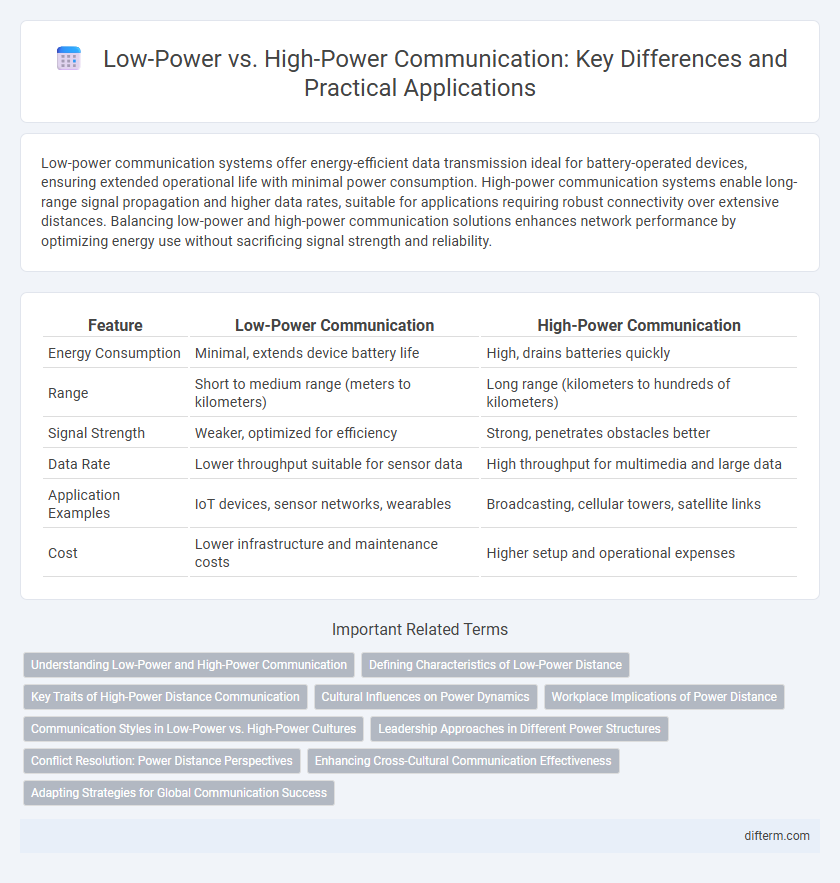Low-power communication systems offer energy-efficient data transmission ideal for battery-operated devices, ensuring extended operational life with minimal power consumption. High-power communication systems enable long-range signal propagation and higher data rates, suitable for applications requiring robust connectivity over extensive distances. Balancing low-power and high-power communication solutions enhances network performance by optimizing energy use without sacrificing signal strength and reliability.
Table of Comparison
| Feature | Low-Power Communication | High-Power Communication |
|---|---|---|
| Energy Consumption | Minimal, extends device battery life | High, drains batteries quickly |
| Range | Short to medium range (meters to kilometers) | Long range (kilometers to hundreds of kilometers) |
| Signal Strength | Weaker, optimized for efficiency | Strong, penetrates obstacles better |
| Data Rate | Lower throughput suitable for sensor data | High throughput for multimedia and large data |
| Application Examples | IoT devices, sensor networks, wearables | Broadcasting, cellular towers, satellite links |
| Cost | Lower infrastructure and maintenance costs | Higher setup and operational expenses |
Understanding Low-Power and High-Power Communication
Low-power communication uses minimal energy by transmitting signals over short distances, making it ideal for battery-operated and IoT devices requiring energy efficiency. High-power communication involves stronger transmission signals suitable for long-range connectivity and robust data transfer in cellular networks and satellite communications. Optimizing the balance between power consumption and signal strength is crucial for effective communication system design.
Defining Characteristics of Low-Power Distance
Low-power distance cultures emphasize equality, minimizing hierarchical gaps between individuals and authority figures, fostering open communication and participative decision-making. These societies encourage direct interaction and challenge to authority, promoting transparency and mutual respect in organizational and social contexts. Communication in low-power distance environments is characterized by informal language, collaborative dialogue, and accessible leadership.
Key Traits of High-Power Distance Communication
High-power distance communication is characterized by clear hierarchical structures where authority is respected and decisions are centralized. Messages often emphasize formality, status, and adherence to established protocols, limiting open dialogue between different power levels. This communication style can influence organizational culture by reinforcing roles and minimizing challenges to authority.
Cultural Influences on Power Dynamics
Low-power communication styles often emphasize indirectness, politeness, and attentiveness, reflecting cultural norms that value harmony and group cohesion, such as in East Asian societies. High-power communication tends to be more direct, assertive, and authoritative, common in Western cultures where individualism and hierarchical status are prioritized. Understanding these cultural influences on power dynamics is crucial for effective cross-cultural communication and avoiding misunderstandings in international contexts.
Workplace Implications of Power Distance
Low-power communication in the workplace encourages open dialogue, employee empowerment, and collaborative decision-making, fostering a culture of trust and innovation. High-power communication often leads to hierarchical structures where information flow is top-down, potentially stifling creativity and employee engagement. Understanding power distance dynamics is crucial for organizations aiming to balance authority with inclusivity to improve overall productivity and job satisfaction.
Communication Styles in Low-Power vs. High-Power Cultures
Communication styles in low-power cultures emphasize equality, open dialogue, and participative decision-making, fostering direct and transparent interactions. High-power cultures prioritize hierarchy, formal communication, and respect for authority, often resulting in indirect and controlled exchanges. Understanding these contrasting styles is essential for effective cross-cultural communication and relationship building.
Leadership Approaches in Different Power Structures
In low-power communication structures, leadership approaches emphasize collaboration, transparency, and empowerment to foster trust and innovation among team members. High-power communication styles often rely on directive leadership, clear hierarchies, and authoritative messaging to ensure control and swift decision-making. Understanding how power dynamics influence communication patterns is essential for adapting leadership strategies that optimize engagement and effectiveness.
Conflict Resolution: Power Distance Perspectives
Low-power individuals frequently approach conflict resolution with a collaborative and empathetic style, emphasizing harmony and mutual understanding to reduce power distance. High-power counterparts tend to adopt a more assertive strategy, focusing on control and authority to quickly resolve disputes, often maintaining hierarchical structures. Understanding these power distance perspectives is crucial for designing effective communication strategies that bridge gaps and foster equitable conflict resolution across organizational and cultural contexts.
Enhancing Cross-Cultural Communication Effectiveness
Low-power communication fosters inclusivity and empathy by encouraging open dialogue and reducing hierarchical barriers, which enhances cross-cultural understanding. High-power communication can establish clear authority but often limits participation and may hinder effective intercultural exchanges due to perceived dominance. Balancing power dynamics through adaptive communication styles improves collaboration and mutual respect in diverse cultural settings.
Adapting Strategies for Global Communication Success
Adapting communication strategies for global success requires balancing low-power approaches, which emphasize humility and active listening to foster trust, with high-power tactics that assert authority and drive decisive action. Understanding cultural preferences in power dynamics enables communicators to tailor messages effectively, enhancing engagement and reducing misunderstandings. Utilizing this adaptive framework improves collaboration across diverse international teams and markets.
low-power vs high-power Infographic

 difterm.com
difterm.com